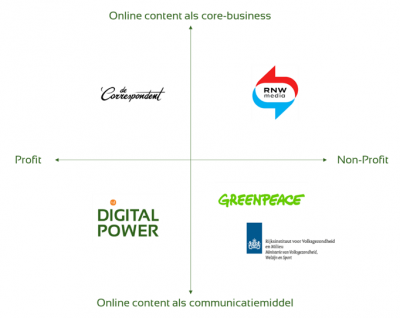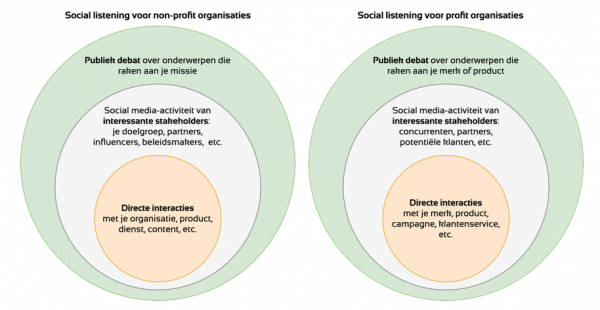What is social listening?
How to analyse large amounts of social media data for valuable insights
- Article
- Data Science

The internet provides a massive amount of interesting social media posts, likes and shares. A wealth of information, especially for organisations wanting to make more impact online. But where do you start? What data will you collect, how will you analyze it and how can you convert insights into concrete action points? To answer these questions, it is important to start with the mission and goals of the organization.
To analyse social media data, you can use the social listening method. Social listening is a research method in which online conversations and messages are monitored and analysed about a particular topic, person, brand or campaign.
With this method we collect data from, for example, social media channels (such as Facebook, Twitter, Instagram), but also from blogs, forums and online news items. The purposes of social listening vary from monitoring direct online customer contact to mapping (online) social developments.
Mapping online conversations and articles (in real-time) provides insights for strategic marketing, reputation management and influencing public opinion. Social listening can help:
- Analyse the popularity/reputation of a product
- Measure the impact of your social media strategy
- Monitor and discover trends and lurkingimpending crises
- Map social developments
- Discover opportunities to connect with your target groups
- Keep an eye on competitors' activities
What types of organisations benefit from social listening?
Social listening is useful for almost any type of (profit and non-profit) organisation. Depending on the type of organisation and the objectives, you can answer different questions with social listening.
We see a distinction between organisations where an online platform comprises the core of the organisation, and organisations that only use online platforms as a means of communication or as part of the marketing communication mix. A number of examples of this distinction are shown in the matrix below.

The Correspondent is an example of an organisation that generates revenue (profit) by recruiting members for their online platform (online content as core business). On their platform, they actively involve members in discussions about the topics they write about.
With Digital Power we generate revenue based on consultancy assignments (profit). We use various online channels to reach potential customers and employees (online content as a means of communication), but these channels are not part of our services.
In the non-profit sector, we see the same distinction: RNW Media is an example of an NGO (non-profit) that strives for social change through discussion on online platforms (online content as core business). An NGO like Greenpeace (non-profit) mainly uses social media as a communication channel to attract donors and volunteers for work that has nothing to do with the social media landscape.
Social listening can also help the public sector monitor social developments. Think, for example, of the RIVM (National Institute for Public Health and the Environment), which monitors the vaccination debate of recent years, or how the public is currently responding to the government's Corona measures.</ font>
Application of social listening for different departments
The above distinction also makes clear to which departments of your organisation social listening matters. For example, for Digital Power, RIVM and Greenpeace it will be especially useful for the marketing, communication & information, or fundraising department.
For De Correspondent and RNW Media, visitors' behaviour on their own online platform is directly intertwined with their products or services. The success of the online platform directly determines the success of the organisation. It is therefore even more important for these organisations to keep a grip on what is happening online.
Social listening step-by-step plan
In the diagram below you can see which steps you need to go through to use social listening as optimally as possible.

The steps in the orange boxes can be programmed manually, or you can use a social listening tool. We will discuss this later on in the article.
The right research question can be formulated based on the goals of your organisation. The research question determines:
- which data must be collected; and
- which analysis is needed to obtain the right insights.
Collecting data
You can choose to collect data from the platforms you use as an organisation. Think of the social media channels you use to draw attention to your organisation or brand.
You can also collect data from sources 'outside' your own platforms. For example, think of interactions on Twitter that are important to your organisation, but that are not directly aimed at your organisation. The same goes for articles from news platforms, forums or blogs.
Below is a schematic representation of the three levels at which social listening can be applied, for both profit and non-profit organisations.

Whether you can actually collect all the data you need depends on several factors:
- The legal GDPR frameworks on the collection of personal data
- Restrictions imposed by platforms such as Facebook, Instagram and Twitter themselves
- Don't forget to consider ethics and the question: "do I want to collect and use this data? ", even if this is allowed and possible.
In addition, not all content that is shared online is relevant to your research question. You are probably not interested in all posts on Twitter or all the news.
That is why it is important to think about how you ensure that you keep irrelevant data out as much as possible, without overlooking any relevant data (this is also called Information Retrieval). For example, you can draw up the most suitable query (search query) based on keywords, hashtags, website and authors' names.
Analysing techniques
Based on the research question, we also determine the correct analysis method. For example, when we are mainly interested in how much, when, and by who a subject or brand is being discussed (what), then we will mainly focus on the number relevant articles, posts, likes, shares, comments, followers, and authors, and when they were posted. For example, we can also see whether certain events have led to an increase in discussion.
If we want to know how people speak about a certain topic or brand, we opt for text-mining or Natural Language Processing techniques (e.g. sentiment analysis or topic modeling). We applied both for process improvement at Fair Wear.
When we want more insight into the online network as a whole, social network analysis offers interesting insights. This allows you to find out, for example, how information spreads through the network (who is sharing information with whom?), whether there are clusters of groups of people (social media bubbles), and who the influencers are within a network.
Manual social listening
Manual social listening is often used by Data Scientists, because it involves programming.
When setting up social listening manually, you use a programming language such as Python or R. You then write a script to scrape a platform or to establish a connection with the API* of the relevant platform, so that you can retrieve the relevant data. You also need to think about how and where data should be stored.
Then Python or R scripts can be written to analyse data. The insights obtained can be visualised in a report or a dashboard.
The advantage of this process is that the API connection and use of R or Python is generally free. A disadvantage is that it takes a lot of time to set this up properly, especially for large projects. In addition, it requires some maintenance because API connections sometimes change, requiring the script to be modified to still be able to collect data.
Social listening using a tool
You can also choose to purchase a (paid) social listening tool. The company behind such a tool is then responsible for maintaining the data collection through API connections. We recommend purchasing a tool, especially if you want to use social listening intensively for a long period of time.
A disadvantage of a social listening tool is that it does not always have all the analysis techniques you have in mind. It is also sometimes unclear which models the tool uses to perform an analysis. We sometimes see that the sentiment analysis of a paid tool often does not work well. For example, the sentence "I like data, but hate programming" is given an unjustified negative sentiment. Unfortunately, because we don't have access to the code behind the model, we can't figure out what's going wrong.
If an analysis technique is missing or does not show the desired results, you can also choose to set up that part yourself. Then the basics – collecting data and less complex analyses – will already be done for you and Data Scientists can get to work with more advanced analyses. If you need help determining the right approach for your goals and questions, please contact us.
*An Application Program Interface (API) is a collection of definitions, protocols and tools to build software applications. Basically, an API specifies how software components should mutually communicate. The API of a social media platform ensures that you can 'communicate' with the platform in order to collect the desired data.
Social listening and ethics
After reading this article you are convinced of the added value of this Data Science application. However, you should not just get started: there are important questions that you should ask yourself. What do you want to achieve with it? And also: is it ethically responsible in your context to apply social listening?
This is an article by Marieke Schulte, Data Science Consultant, Digital Power
Marieke has a background in social and development policy and evaluating it, using (ethically sound) data.
Chair Digital Power Datahub+31(0)6 10 93 54 60marieke.schulte@digital-power.com
Receive data insights, use cases and behind-the-scenes peeks once a month?
Sign up for our email list and stay 'up to data':